There are a number of things that can go wrong when growing any plant, but roses in particular bring along some specific difficulties. The most beautiful heirloom varieties can be the most susceptible to the worst diseases and pests.
Use this handy guide to learn how to prevent, identify and treat common rose problems before they take hold of your garden.
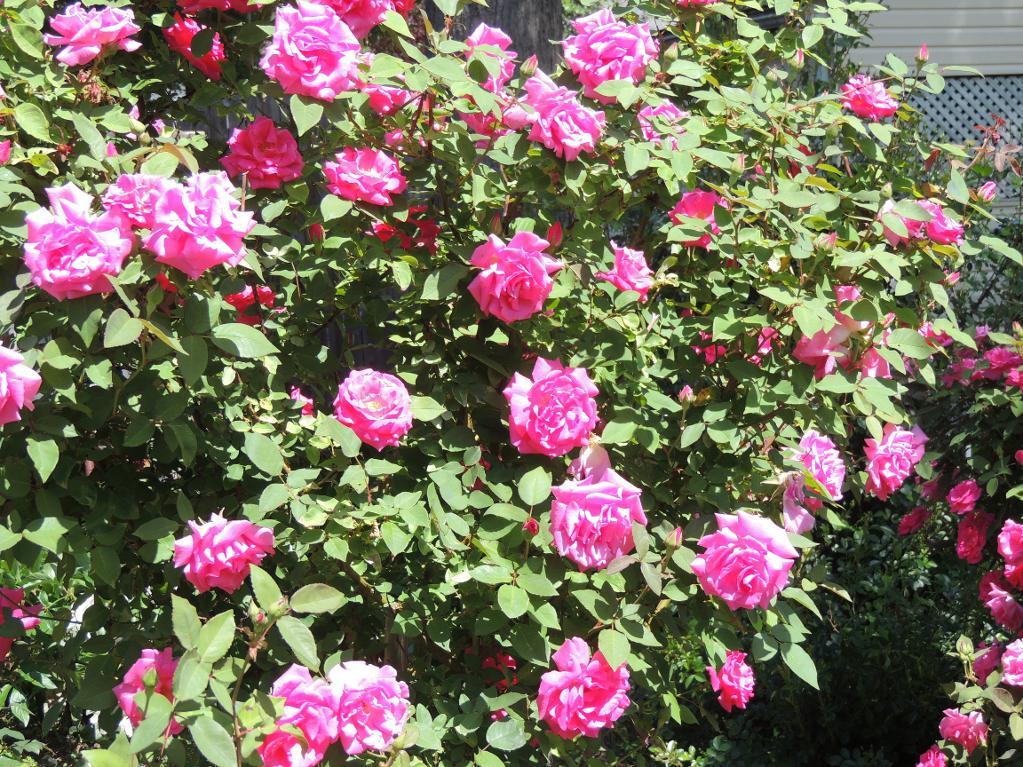
Photo via arabelapi4042081
Learn Accessible Techniques for Easy Rose Gardening!
Enjoy expert instruction from The Biltmore Estate’s exclusive rose consultant, Paul Zimmerman, in the online class A Gardener’s Guide to Growing Roses. Enroll Now »
Preventing rose problems
The best thing you can do to ensure healthy roses is choose disease-resistant varieties. These roses have been bred to resist all of the major diseases roses face each season and they’re well worth the extra cost.
Besides choosing disease-resistant rose varieties, the next best thing you can do to prevent issues with pests and disease is to provide good air circulation around the plants, and water them properly. Most troublesome diseases and pests attack plants that are already stressed from overcrowding or improper care.
Early detection can also save you and your rose bushes a big headache later on. Spending time in your rose garden will make it easy to identify problems as soon as they show.
Let’s go through the most common diseases and pests to afflict roses so you’ll know just what to look for when smelling your beautiful roses.
Common rose diseases
1. Powdery mildew
Powdery mildew usually appears in summer, when the days are hot and dry and the nights are cool and wet. It can appear on leaves, flowers or stems and usually attacks new growth first. Powdery mildew causes leaves to curl and twist with white powdery spots on the top and bottom of leaves.

Photo via Creative Commons/Scot Nelson
Powdery mildew prevention and treatment
Avoid powdery mildew by watering your roses at the ground level in the morning, allowing them to dry completely by nightfall. Powdery mildew is also brought on by overcrowding. Make sure your roses have room to breathe by planting them with enough distance apart and pruning to better facilitate air flow.
Powdery mildew can be controlled with a fungicide spray, or for a more organic solution, try mixing milk with water in a ratio of 1 part milk to 9 parts water and spraying on the foliage. This won’t completely get rid of the mildew, but it will help to control its spread.
2. Black spot
Black spot is one of the most common diseases to afflict roses. As a waterborne disease, it will appear during humid weather and spread through irrigation. Black spot appears as circular black or brown spots on the tops of leaves. The disease first shows on lower branches and moves its way upward. Leaves that are infected with black spot will eventually turn yellow and fall off the plant. This fungus attacks plants that lack good air circulation or have been sitting in wet conditions, especially overnight.

Photo licensed via Creative Commons/Scot Nelson
Black spot prevention and treatment
Prevent black spot by choosing rose varieties that are resistant to it. It will also help to water roses in the early morning and at ground level to avoid leaves sitting with water on them.
Fungicide sprays can help stop the spread and heal rose bushes. Begin treatment as soon as you spot this disease. Pruning affected canes and removing fallen leaves will also help stop the spread of black spot.
3. Mosaic virus
Yellow mottling on rose leaves is the first sign of mosaic virus, followed by dropped leaves and dead plants. A mild infection of mosaic may not cause any lasting problems, but severe infections can destroy a rose bush.
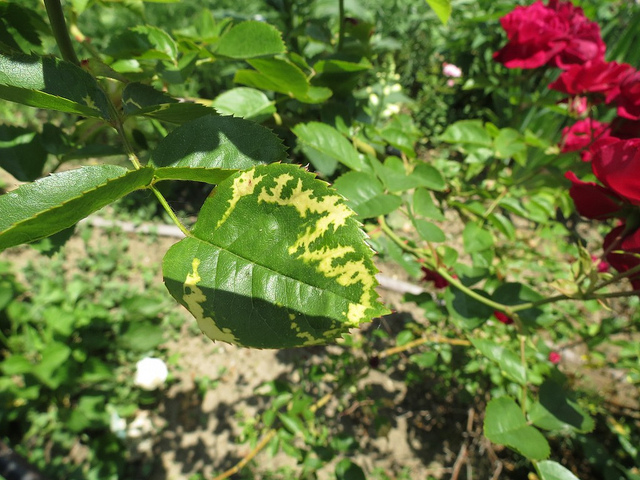
Photo sourced via Creative Commons/Malcom Manners
Mosaic virus prevention and treatment
Choose disease-resistant roses from the start. Once mosaic sets in, it can’t be cured. Affected plants will need to be removed and destroyed.
4. Rust
Rust shows itself in orange spots on the underside of leaves and canes. Leaves may fall off if the plant is severely afflicted.
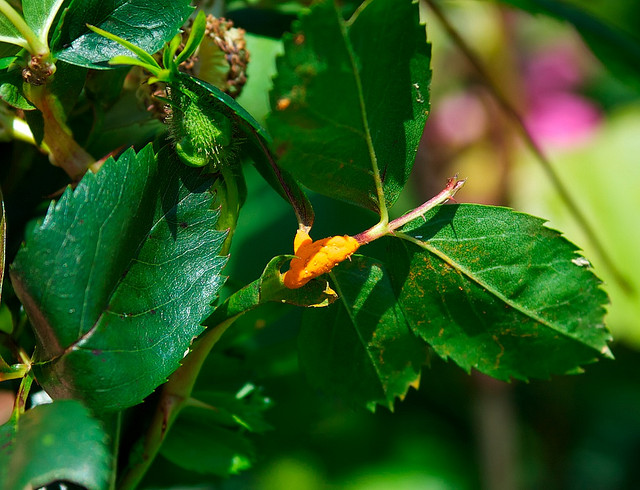
Sourced via Creative Commons/Malcom Manners
Rust prevention and treatment
Prevent rust by selecting disease-resistant varieties and giving plants plenty of space to breathe. Fungicides can be used to stop the spread of rust.
Common rose pests
Wondering who’s been nibbling your roses? There are a number of annoying pests just waiting to chomp down on your roses. Frequent rose inspection will help you to catch bugs before they settle in for the long haul. Be sure to look under leaves and in the soil around the base of plants as well.
1. Aphids
Aphids are very tiny insects that come in a range of colors from green to black. They won’t be noticed at a glance, but looking closely you can identify the little flea-like insects coating your roses.
To get rid of aphids organically, just blast them with a strong stream of water from the hose a couple of times. They’ll eventually move on. You can also use insecticidal soaps or try to encourage their natural predators, ladybugs, to make a home in your garden.
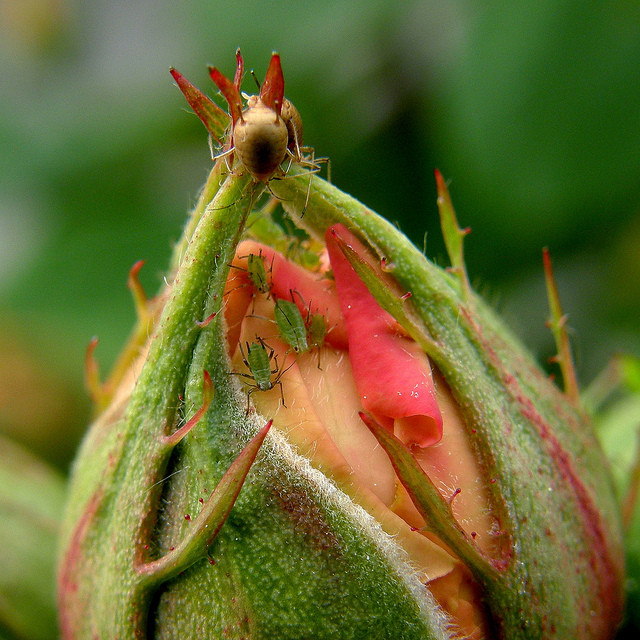
Photo via Creative Commons/Olivier Bacquet
3. Sawfly/rose slug
Rose slugs are the larvae of the adult sawfly and will attack rose leaves, leaving just the skeleton of the leaf behind. These bugs can usually be found on the underside of the leaves and can make quick work of destroying your prized plants. They look just like green caterpillars and can be hand-picked off leaves or treated with insecticidal soap.

Photo via Creative Commons/Line Sabroe
4. Leaf cutter bee
The leaf cutter leaves sure signs behind, perfectly circular holes in your rose leaves. These bees use the foliage to build their nests. Leaf cutters don’t do much harm to rose bushes and are in fact good bugs that your garden needs for pollination. Leave them be, there’s nothing you can do and the damage is purely cosmetic.
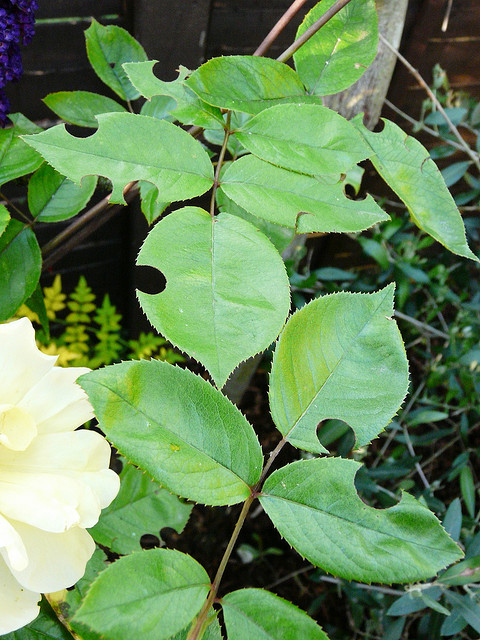
Photo via Creative Commons/Chris Worden
5. Spider mites
If your rose leaves are turning yellow with tiny white dots, you may just have a spider mite infestation. These teeny insects are almost invisible to the naked eye, but can do a lot of damage. Spider mites usually live on the underside of leaves and occasionally leave webbing on the stems. They can be controlled with insecticidal soap or neem oil.
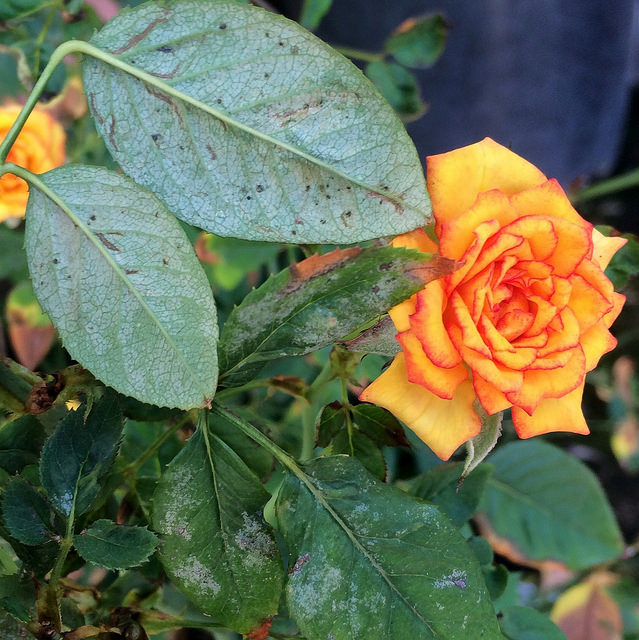
Photo via Creative Commons/Scot Nelson
6. Japanese beetles
The bane of the gardener’s existence, Japanese beetles, can cause extensive damage in a short amount of time. These insects are unmistakable with their metallic green and black bodies and come in hordes to overtake your garden. They can be driven out with the use of insecticide, hand picking and crushing, or using Japanese beetle traps far away from your roses.

Photo via Creative commons/S. Pisharam
While there are clearly plenty of things that can go wrong when growing roses, it’s our hope that this guide will help you to quickly identify and eradicate the problem before it truly takes hold. Prevention is key, and failing that, early detection will work in your favor.
Learn Accessible Techniques for Easy Rose Gardening!
Enjoy expert instruction from The Biltmore Estate’s exclusive rose consultant, Paul Zimmerman, in the online class A Gardener’s Guide to Growing Roses. Enroll Now »


My rose bush has a wax growing mushroom growing onit